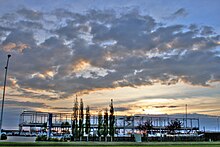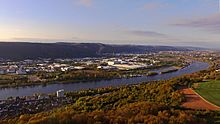Thành viên:Chỉ Có Ở Việt Nam/Bất động sản công nghiệp


Bất động sản công nghiệp (tiếng Anh: industrial park hoặc industrial estate hay trading estate), is an area zoned and planned for the purpose of industrial development. An industrial park can be thought of as a more heavyweight version of a business park or office park, which has offices and công nghiệp nhẹ, rather than công nghiệp nặng. Industrial parks are notable for being relatively simple to build; they often feature speedily erected single-space steel sheds, occasionally in bright colours.
Benefits[sửa | sửa mã nguồn]


Industrial parks are usually located on the edges of, or outside, the main residential area of a city, and are normally provided with good transportation access, including road and rail.[1] One such example is the large number of industrial estates located along the River Thames in the Thames Gateway area of London. Industrial parks are usually located close to transport facilities, especially where more than one transport modes coincide, including highways, railroads, airports and ports. Another common feature of a North American industrial park is a water tower, which helps to hold enough water to meet the park's demands and for firefighting purposes, and also advertises the industrial park and locality, as usually the community's name and logo are painted onto its surface.[2]
This idea of setting land aside through this type of zoning has several purposes:
- By concentrating dedicated infrastructure in a delimited area, to reduce the per-business cost of that infrastructure. Such infrastructure includes roadways, railroad sidings, ports, high-power electric supplies (often including three-phase electric power), high-end communications cables, large-volume water supplies, and high-volume gas lines.[3]
- To attract new business by providing an integrated infrastructure in one location.
- Eligibility of Industrial Parks for benefits.[4][5]
- To set apart industrial uses from urban areas[6] to try to reduce the environmental and social impact of the industrial uses.
- To provide for localized environmental controls that are specific to the needs of an industrial area.
Benchmarking[sửa | sửa mã nguồn]
For the manufacturing companies located in industrial parks, the performance of industrial park operators is important, as the costs for infrastructure and services charged by the industrial park operator is a serious factor for the competitiveness of the manufacturing companies.[7][8]
Criticism[sửa | sửa mã nguồn]
Different industrial parks fulfill these criteria to differing degrees. Many small communities have established industrial parks with only access to a nearby highway, and with only the basic utilities and roadways. Public transportation options may be limited or non-existent.
Industrial parks in developing countries such as Pakistan face a myriad of additional difficulties. This includes the availability of a skilled workforce and the clustering together of radically different industrial sectors (pharmaceuticals and heavy engineering, for example), which often leads to unfavorable outcomes for quality centered industries.[cần dẫn nguồn]
Variations[sửa | sửa mã nguồn]
An industrial park specializing in biotechnology is called a biotechnology industrial park. It may also be known as a bio-industrial park or eco-industrial cluster.
Flatted factories exist in cities like Singapore and Hong Kong, where land is scarce. These are typically similar to flats, but house individual industries instead. Flatted factories have cargo lifts and roads that serve each level, providing access to each factory lot.
Countries[sửa | sửa mã nguồn]
Ấn Độ[sửa | sửa mã nguồn]
India was one of the first countries in Asia to recognize the effectiveness of the Export Processing Zone (EPZ) model in promoting exports, with Asia's first EPZ set up in Kandla in 1965. In order to overcome the shortcomings experienced on account of the multiplicity of controls and clearances; absence of world-class infrastructure, and an unstable fiscal regime and with a view to attract larger foreign investments in India, the Special Economic Zones (SEZs) Policy was announced in April 2000.A special economic zone (SEZ) is a geographical region that has economic laws that are more liberal than a country's domestic economic laws. India has specific laws for its SEZs.The category 'SEZ' covers a broad range of more specific zone types, including free-trade zones (FTZ), export processing zones (EPZ), free zones (FZ), industrial estates (IE), free ports, urban enterprise zones and others. Usually, the goal of a structure is to increase foreign direct investment by foreign investors, typically an international business or a Multi National Corporation (MNC).
Notable SEZs in India
- DGDC SEZ, Surat (SURSEZ)
- Dholera SEZ, Gujarat
- Divi's Laboratories Limited Chippada Village, Visakhapatnam, Andhra Pradesh Pharmaceuticals
- DLF Cyber City, Gurgaon Gurgaon, Haryana IT/ITES
- HCL ELCOT SEZ – Sholingnalur, Chennai
- HCL IT city, Lucknow, Uttar Pradesh IT & Start-Up
- Infosys Technologies SEZ Mangaluru Bengaluru, Karnataka IT/ITES
- Jindal Steel and Power, Choudwar
- Kandla SEZ, Gandhidham, Gujarat{KASEZ}
- POSCO India SEZ, Paradeep
- Mundra Port & Special Economic Zone, Multi Product
- Maharashtra Industrial Development Corporation Ltd., Pune - IT/ITES
- Reliance Jamnagar Infrastructure Ltd. Jamnagar Multi Product
- Zydus Infrastructure Pvt. Ltd. Sanand, Ahmedabad Pharmaceutical
- Larsen & Toubro Limited's IT/ ITeS SEZ at Surat, Gujarat
- Calica Group's "3rd eye voice" IT/ITES SEZ, Ahmedabad
- Gallops Engineering SEZ, Moraiyya, Near Changodar, Ahmedabad
- Vatva Ahmedabad
- Infocity IT Park, IT/ITES, Gandhinagar, Gujarat
- GIFT SEZ, GIFT CITY, Gandhinagar, Gujarat
- DAHEJ SEZ 1 and 2, Tal Vagra, Bharuch
- TCS Garima Park IT/ITES SEZ, Gandhinagar
- WIPRO Limited Doddakannelli Village, Varthur Hobli, Electronic City, Bengaluru IT
Thổ Nhĩ Kỳ[sửa | sửa mã nguồn]
An organized industrial zone (tiếng Thổ Nhĩ Kỳ: Organize Sanayi Bölgesi) is a kind of special economic zone in Turkey. These zones were legislated for between 2000 and 2007, and may bring together related (OIZs for function) industries or just be a special zone for many industries (mixed OIZs). Not every industry is allowed to operate in organized industrial zones.[9] Organized industrial zones are not duty-free, but there are considerable tax[cần dẫn nguồn] and location(by making related industries closer) advantages. OIZs are related to[cần giải thích] industrial parks in some countries.[cần dẫn nguồn]
Xem thêm[sửa | sửa mã nguồn]
Tham khảo[sửa | sửa mã nguồn]
- ^ Industrial park scheme 2008 “Archived copy” (PDF). Bản gốc (PDF) lưu trữ ngày 3 tháng 12 năm 2008. Truy cập ngày 11 tháng 6 năm 2009.Quản lý CS1: bản lưu trữ là tiêu đề (liên kết)
- ^ Ferebee, Johanna (20 tháng 8 năm 2019). “New water tower to serve Brunswick-Columbus industrial parks gets design funding”. PortCityDaily. Truy cập ngày 9 tháng 10 năm 2019.
- ^ Industrial Park land and infrastructure http://www.ground57.com/land-and-infrastructure/ Lưu trữ 2018-05-21 tại Wayback Machine
- ^ Industrial Park Benefits “Archived copy” (PDF). Bản gốc (PDF) lưu trữ ngày 23 tháng 11 năm 2010. Truy cập ngày 4 tháng 6 năm 2009.Quản lý CS1: bản lưu trữ là tiêu đề (liên kết)
- ^ List of Approvals & Withdrawals under the Industrial Park Schemes, 1999 & 2002 “Archived copy” (PDF). Bản gốc (PDF) lưu trữ ngày 21 tháng 7 năm 2011. Truy cập ngày 11 tháng 6 năm 2009.Quản lý CS1: bản lưu trữ là tiêu đề (liên kết)
- ^ “Orthodox Residents in Sanhedria Frightened Of Industrial Zone”. The Jewish Press. 7 tháng 1 năm 1994.
in an uproar over a proposed industrial zone
- ^ Festel, Gunter; Würmseher, Martin (tháng 5 năm 2014). “Benchmarking of energy and utility infrastructures in industrial parks”. Journal of Cleaner Production (bằng tiếng Anh). 70: 15–26. doi:10.1016/j.jclepro.2014.01.101.
- ^ Festel, Gunter; Würmseher, Martin (30 tháng 9 năm 2014). “Benchmarking of industrial park infrastructures in Germany”. Benchmarking (bằng tiếng Anh). 21 (6): 854–883. doi:10.1108/BIJ-01-2013-0015. ISSN 1463-5771.
- ^ "http://gosb.com/filem/4562OSBKanunu.pdf Lưu trữ 2015-07-05 tại Wayback Machine
Liên kết ngoài[sửa | sửa mã nguồn]
| Wikimedia Commons có thêm hình ảnh và phương tiện truyền tải về BĐS công nghiệp. |
Bản mẫu:Phát triển dự án bất động sản Bản mẫu:Công nghệ sinh học
